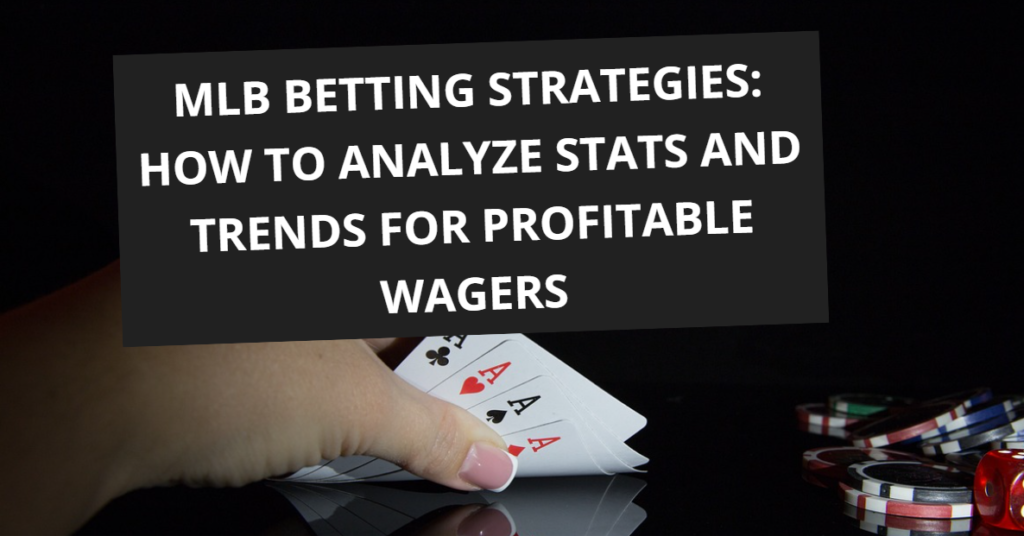Major League Baseball (MLB) offers a wealth of opportunities for sports bettors to capitalize on. However, success in MLB betting requires more than just luck – it demands a strategic approach that involves analyzing statistics and trends to make informed wagering decisions.
In this guide, we’ll explore effective MLB betting strategies that leverage statistical analysis and trend evaluation to maximize profitability.

Statistical Analysis:
Statistical analysis forms the backbone of successful MLB betting strategies. By examining various performance metrics and historical data, bettors can identify patterns and trends that inform their betting decisions. Some key statistics to consider include:
Batting Statistics: This includes metrics such as batting average (AVG), on-base percentage (OBP), slugging percentage (SLG), and weighted runs created plus (wRC+). These stats help assess a team’s offensive prowess and individual player performance.
Pitching Statistics: Pitching metrics like earned run average (ERA), fielding independent pitching (FIP), strikeout rate (K%), and walk rate (BB%) provide insights into a team’s pitching staff’s effectiveness and individual pitcher performance.
Advanced Metrics: Advanced statistics like wins above replacement (WAR), expected weighted on-base average (xwOBA), and defensive runs saved (DRS) offer a deeper understanding of player value and overall team performance.
Trend Evaluation:
In addition to statistical analysis, bettors should also evaluate trends that may influence game outcomes. These trends can encompass various factors, including:
Team Performance Trends: Assessing how teams perform in different situations, such as home vs. away games, against division rivals, or in specific months of the season, can reveal valuable insights.
Pitching Matchup Trends: Examining historical data on pitching matchups, including head-to-head records, individual pitcher performance against specific opponents, and recent form, can help bettors predict pitching duels’ outcomes.
Weather and Stadium Trends: Considering how weather conditions, ballpark dimensions, and playing surfaces impact game outcomes can provide an edge. For example, games played in hitter-friendly ballparks or in hot, humid weather may favor offenses.
Line Shopping:
Effective MLB betting strategies also involve line shopping – comparing odds from multiple sportsbooks to find the best value. Since different sportsbooks may offer slightly different odds on the same game, bettors should shop around to maximize potential profits. Utilizing odds comparison websites or mobile betting apps can streamline the line shopping process and ensure bettors secure the most favorable odds available.
Bankroll Management:
Bankroll management is a fundamental aspect of successful sports betting, including MLB wagering. Implementing a disciplined approach to bankroll management involves setting and sticking to a budget, determining the size of each wager based on bankroll size and risk tolerance, and avoiding chasing losses or betting more than one can afford to lose. By managing their bankroll effectively, bettors can mitigate risk and sustain long-term profitability.
In-Game Betting Opportunities:
In addition to pre-game betting, savvy MLB bettors can capitalize on in-game betting opportunities to maximize profits. In-game betting allows bettors to wager on various outcomes during the course of a game, such as the result of the next at-bat, inning totals, or live moneyline odds. By closely following the action and identifying favorable betting opportunities, bettors can exploit inefficiencies in the market and secure profitable wagers.
Pitcher vs. Batter Matchup Analysis:
Examining individual matchups between pitchers and batters can provide valuable insights into potential game outcomes. By analyzing historical performance data, including batter-pitcher matchups and advanced statistics such as on-base plus slugging percentage (OPS) against specific pitchers, bettors can identify advantageous matchups or potential weaknesses to exploit.
Factors to consider include the handedness of the pitcher and batter, pitch types each hitter struggles against, and historical success rates in similar situations. This nuanced approach allows bettors to make more informed decisions when betting on player-specific outcomes, such as hits, strikeouts, or home runs.
Injury and Roster News:
Staying abreast of injury updates and roster changes is crucial for effective MLB betting. Injuries to key players, changes in starting lineups, or unexpected roster moves can significantly impact game dynamics and alter betting probabilities. By monitoring injury reports, lineup announcements, and roster transactions, bettors can adjust their betting strategies accordingly and capitalize on favorable or mispriced betting opportunities.
Additionally, being aware of teams’ depth charts and the impact of substitutions or call-ups can provide valuable insights into potential game outcomes and player performances. Keeping a close eye on injury and roster news enables bettors to adapt quickly to changing circumstances and make more informed wagering decisions.
Conclusion:
Effective MLB betting strategies rely on statistical analysis, trend evaluation, line shopping, bankroll management, and in-game betting tactics.
By leveraging these strategies, bettors can gain a competitive edge in the MLB betting market and increase their chances of long-term profitability. Whether you’re a seasoned bettor or new to MLB wagering, incorporating these strategies into your approach can help you make smarter, more profitable wagers on America’s favorite pastime.